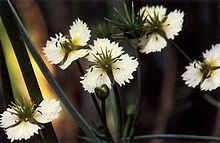Damasonium
| starfruit | |
|---|---|

| |
| Damasonium californicum | |
| Scientific classification | |
| Kingdom: | |
| (unranked): | |
| (unranked): | |
| Order: | |
| Family: | |
| Genus: | Damasonium |
| Species | |
|
See text | |
Damasonium is a genus of six species of flowering plants in the family Alismataceae, commonly known as starfruit and by the older name thrumwort. The genus has a subcosmopolitan but very patchy distribution.[1][2][3][4]
They are aquatic perennial herbaceous plants growing in shallow water or mud beside ponds. The leaves are all basal, floating, or aerial in plants on pond margins. The flowers are hermaphrodite, in one to many whorls, in umbels, racemes or panicles; they have six stamens, and six to nine carpels arranged in a whorl, connate at the base, each with two to many ventral ovules; The styles are terminal. The fruit is a whorl of follicles; the follicles are laterally compressed, stellately radiating, with a more or less elongated apical beak.[3][4]
Species
There are at the present time (May 2014) six currently accepted species:[5][6]
- Damasonium alisma Mill. (syn. D. stellatum Thuill.; D. polyspermum Cosson; D. constrictum Juz.). - Great Britain, France, Portugal, Spain, Italy, Greece, Russia, Ukraine, Moldova, Kazakhstan
- Damasonium bourgaei Coss. - Mediterranean Basin and India
- Damasonium californicum Torr. ex Benth. - western United States (Idaho, Oregon, Nevada, California, Montana, Washington State)[7]
- Damasonium constrictum Juz. -Kazakhstan and Altay region of Siberia
- Damasonium minus (R. Br.) Buchenau (syn. D. australe Salisb.). Australia.
- Damasonium polyspermum Coss. - Spain, France, Portugal, Greece, Sicily, Algeria, Libya, Morocco
Ecology
Damasonium alisma grows in acidic ponds. In Great Britain it went into decline along with the village pond. It once grew in many English counties from Sussex north to Shropshire, but by 1900 was reduced to two ponds in Buckinghamshire and one in Surrey. It is gradually starting to make a come back due to intense conservation efforts. It requires open, well-lit, shallow water to grow in and regularly churned up mud for its seeds to germinate.
It is very variable in form according to the depth of the water it is growing in. Dwarf plants with aerial leaves occur growing sub-terrestrially on mud. The number of ovules vary. Usually there are two in each carpel, but carpels with four to many occur over the range. Multi-ovulate forms from southwestern Europe and Sicily were originally described as D. polyspermum.
The shape of the follicles depends on the number of seeds; the beak (empty upper part) of the carpel is elongated in two-seeded plants, whereas in many-seeded plants the seeds occupy more of the follicle and the beak is relatively shorter and less well defined.
References
- ^ Germplasm Resources Information Network: Damasonium
- ^ Australian Plant Name Index: Damasonium
- ^ a b Flora of NW Europe: Damasonium
- ^ a b Flora of North America: Damasonium
- ^ Kew World Checklist of Selected Plant Families
- ^ Altervista Flora Italiana, Mestolaccia stellata, Starfruit, Damasonium
- ^ Biota of North America Program
